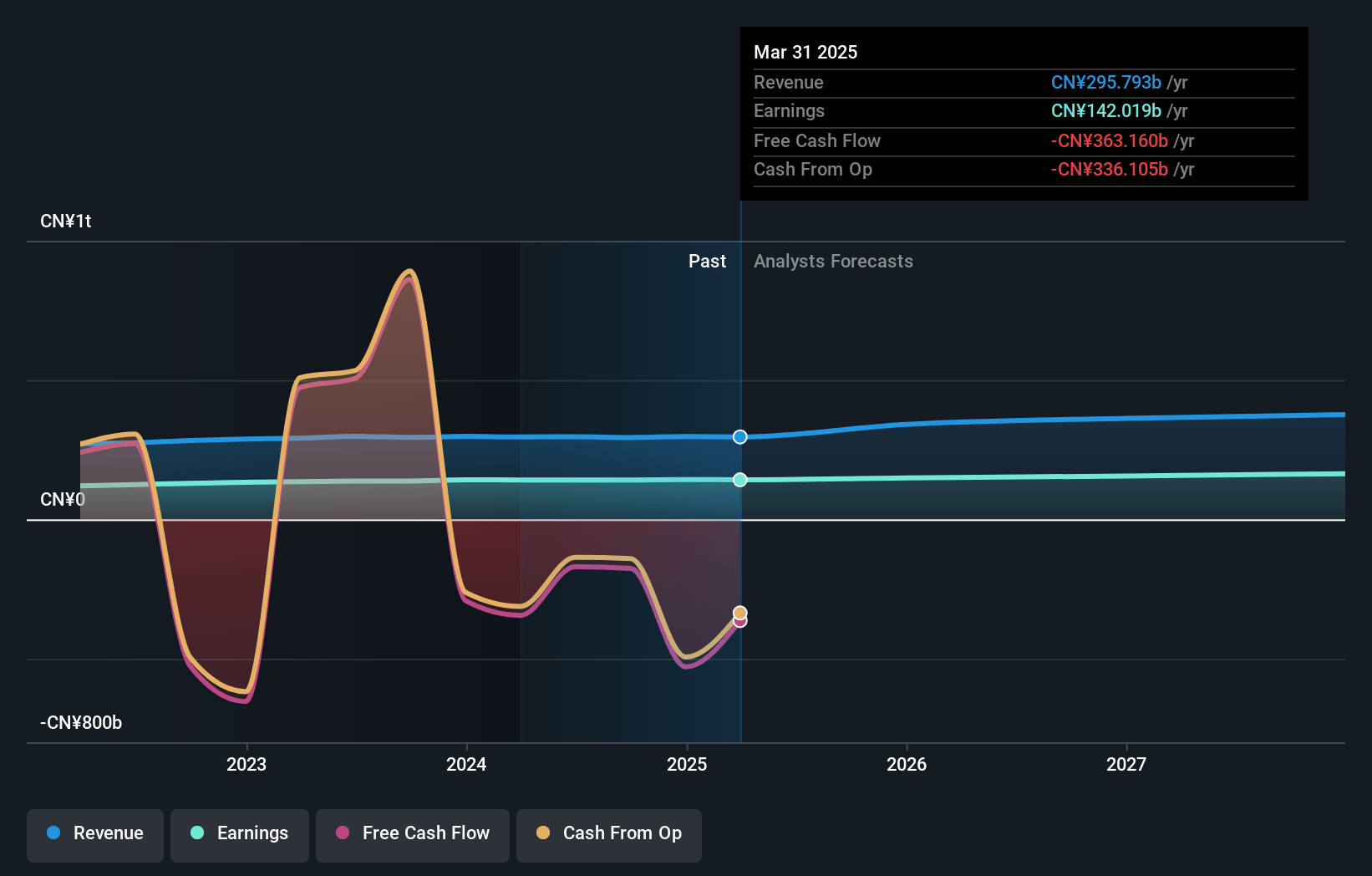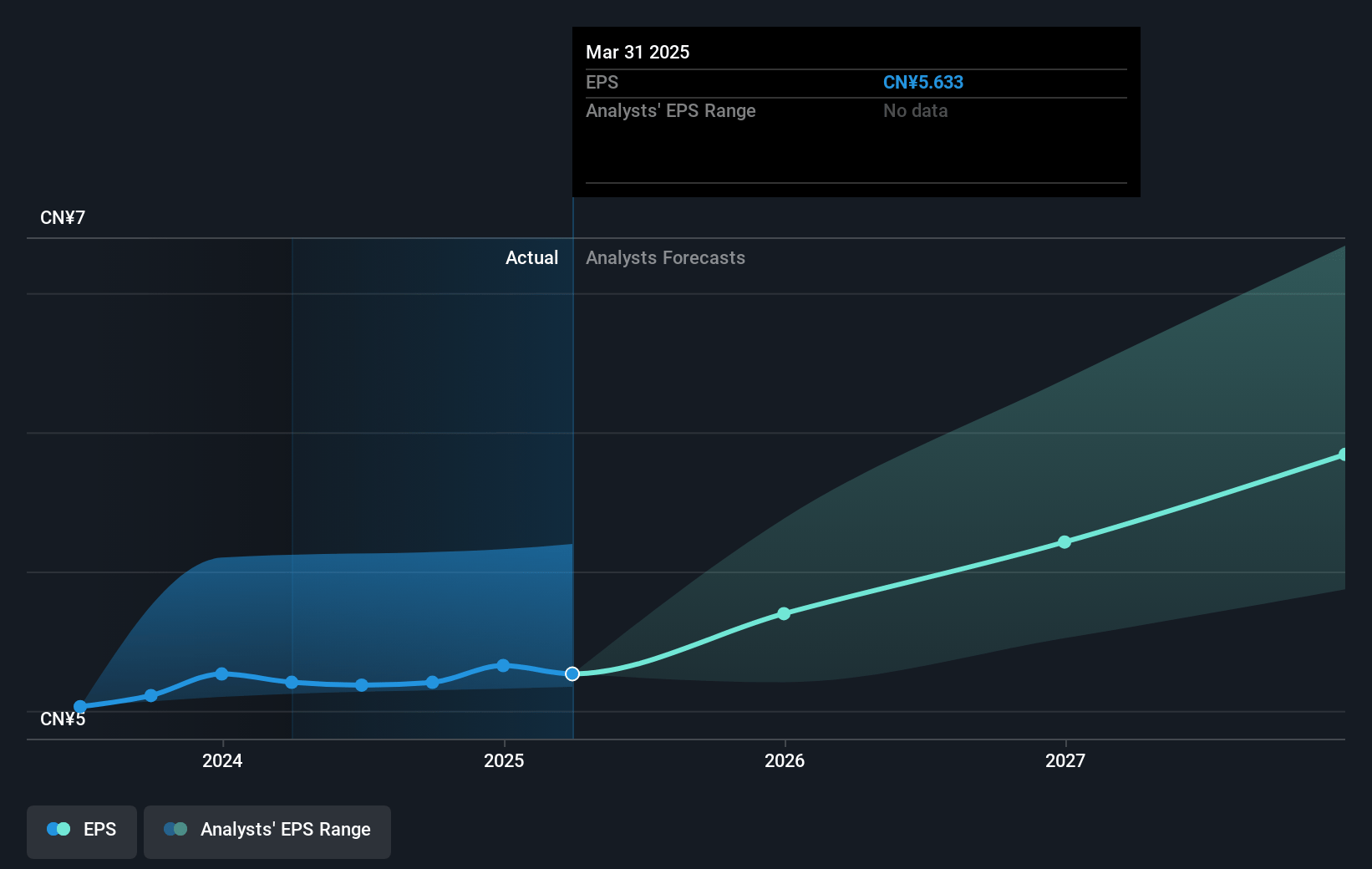Key Takeaways
- Focus on retail finance and technological investments in AI and R&D will likely increase operational efficiency and revenue from improved service delivery.
- International expansion and green financing initiatives align with global trends, potentially boosting revenue and enhancing corporate image.
- Revenue growth and net margins are pressured by declining interest rates, increased non-performing loans, and economic challenges, impacting asset quality and profitability.
Catalysts
About China Merchants Bank- Provides various banking products and services.
- The expansion and focus on retail finance, particularly the growth in the number of retail customers and the assets under management (AUM) from these customers, indicates future potential for increased revenue from this segment.
- The significant investment and early adoption of AI and technology (over 10,000 R&D personnel and substantial IT expenditure) are expected to enhance operational efficiency, potentially leading to improved net margins as the bank leverages AI to reduce costs and improve service delivery.
- The international expansion plan, focusing on providing global accounts, cash management, and other services to Chinese enterprises going global, presents opportunities for revenue growth from international operations and cross-border transactions.
- The bank's growing involvement in ESG and green financing, including its issuance of climate change mitigation bonds, indicates an alignment with sustainable finance, which may attract new segments of investors and clients, potentially boosting revenue and enhancing the corporate image.
- The proactive participation in the AI + finance initiative and the development of intelligent banking systems are expected to lower operational costs and enhance customer experience, contributing to higher earnings through increased service uptake and customer retention.
China Merchants Bank Future Earnings and Revenue Growth
Assumptions
How have these above catalysts been quantified?- Analysts are assuming China Merchants Bank's revenue will grow by 10.9% annually over the next 3 years.
- Analysts assume that profit margins will shrink from 48.0% today to 43.1% in 3 years time.
- Analysts expect earnings to reach CN¥173.7 billion (and earnings per share of CN¥6.79) by about May 2028, up from CN¥142.0 billion today. However, there is some disagreement amongst the analysts with the more bearish ones expecting earnings as low as CN¥154.1 billion.
- In order for the above numbers to justify the analysts price target, the company would need to trade at a PE ratio of 8.9x on those 2028 earnings, up from 7.2x today. This future PE is greater than the current PE for the CN Banks industry at 6.0x.
- Analysts expect the number of shares outstanding to decline by 0.11% per year for the next 3 years.
- To value all of this in today's terms, we will use a discount rate of 8.03%, as per the Simply Wall St company report.
China Merchants Bank Future Earnings Per Share Growth
Risks
What could happen that would invalidate this narrative?- The company's net operating income experienced a year-over-year decrease of 0.58%, reflecting potential challenges in maintaining revenue growth in a competitive market with declining interest and fee rates.
- The net interest margin (NIM) decreased by 17 basis points to 1.98%, indicating potential pressure on the bank's ability to maintain net margins amid a low interest rate environment.
- The non-performing loan (NPL) balance increased by CN¥4.03 billion, posing a risk to asset quality and potentially impacting net earnings due to higher provisions for bad loans.
- The allowance coverage ratio decreased by 25.72 percentage points, which may challenge the bank's risk compensation capabilities and affect its ability to absorb credit losses, impacting profitability.
- Economic conditions such as sluggish consumption and insufficient effective credit demand create operational challenges, which could pressure revenue growth and net margins going forward.
Valuation
How have all the factors above been brought together to estimate a fair value?- The analysts have a consensus price target of CN¥48.659 for China Merchants Bank based on their expectations of its future earnings growth, profit margins and other risk factors. However, there is a degree of disagreement amongst analysts, with the most bullish reporting a price target of CN¥55.5, and the most bearish reporting a price target of just CN¥38.68.
- In order for you to agree with the analyst's consensus, you'd need to believe that by 2028, revenues will be CN¥403.0 billion, earnings will come to CN¥173.7 billion, and it would be trading on a PE ratio of 8.9x, assuming you use a discount rate of 8.0%.
- Given the current share price of CN¥40.74, the analyst price target of CN¥48.66 is 16.3% higher.
- We always encourage you to reach your own conclusions though. So sense check these analyst numbers against your own assumptions and expectations based on your understanding of the business and what you believe is probable.
How well do narratives help inform your perspective?
Disclaimer
AnalystConsensusTarget is a tool utilizing a Large Language Model (LLM) that ingests data on consensus price targets, forecasted revenue and earnings figures, as well as the transcripts of earnings calls to produce qualitative analysis. The narratives produced by AnalystConsensusTarget are general in nature and are based solely on analyst data and publicly-available material published by the respective companies. These scenarios are not indicative of the company's future performance and are exploratory in nature. Simply Wall St has no position in the company(s) mentioned. Simply Wall St may provide the securities issuer or related entities with website advertising services for a fee, on an arm's length basis. These relationships have no impact on the way we conduct our business, the content we host, or how our content is served to users. The price targets and estimates used are consensus data, and do not constitute a recommendation to buy or sell any stock, and they do not take account of your objectives, or your financial situation. Note that AnalystConsensusTarget's analysis may not factor in the latest price-sensitive company announcements or qualitative material.




